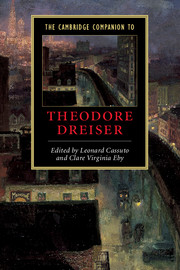Book contents
- Frontmatter
- Introduction
- Part I Backgrounds and contexts
- Part II Dreiser and his culture
- 5 The matter of Dreiser’s modernity
- 6 Dreiser, class, and the home
- 7 Can there be loyalty in The Financier? Dreiser and upward mobility
- 8 Dreiser, art, and the museum
- 9 Dreiser and women
- 10 Sister Carrie, race, and the World’s Columbian Exposition
- 11 Dreiser’s sociological vision
- 12 Dreiser and crime
- Select bibliography
- Index
5 - The matter of Dreiser’s modernity
from Part II - Dreiser and his culture
Published online by Cambridge University Press: 28 May 2006
- Frontmatter
- Introduction
- Part I Backgrounds and contexts
- Part II Dreiser and his culture
- 5 The matter of Dreiser’s modernity
- 6 Dreiser, class, and the home
- 7 Can there be loyalty in The Financier? Dreiser and upward mobility
- 8 Dreiser, art, and the museum
- 9 Dreiser and women
- 10 Sister Carrie, race, and the World’s Columbian Exposition
- 11 Dreiser’s sociological vision
- 12 Dreiser and crime
- Select bibliography
- Index
Summary
When Theodore Dreiser wrote a sketch about “Christmas in the Tenements” (1902), he might have written about the persistence, despite the poverty, of family ritual or religious sentiment. He might have described the simple pleasures of a holiday. But he wrote instead about the longing for things. The sketch exhibits a “wealth of feeling and desire,” but both are expressed “through the thinnest and most meager material forms.”
The sketch became the penultimate chapter of The Color of a Great City (1926), a collection of articles written before World War I, before the “splendor” of the “new-world metropolis” had been considerably tamed (vii). That splendor - Manhattan’s “color” - derived from its diversity, the “meaner” regions of the Bowery and East Broadway, the ethnic neighborhoods, the “maidens in orange and green skirts” in Little Italy, for instance, “with a wealth of black hair fluffed back from their foreheads, and yellow shawls and coral necklaces fastened about their necks” (268). By the 1890s, in fact, the “color” of America’s great cities had become almost as marketable as the “local color” of rural America, which flooded the popular monthlies. For Dreiser, the “local life” that Eugene Field had written about in Chicago’s Daily News “moved [him[ as nothing hitherto had.”
- Type
- Chapter
- Information
- The Cambridge Companion to Theodore Dreiser , pp. 83 - 99Publisher: Cambridge University PressPrint publication year: 2004
- 3
- Cited by



